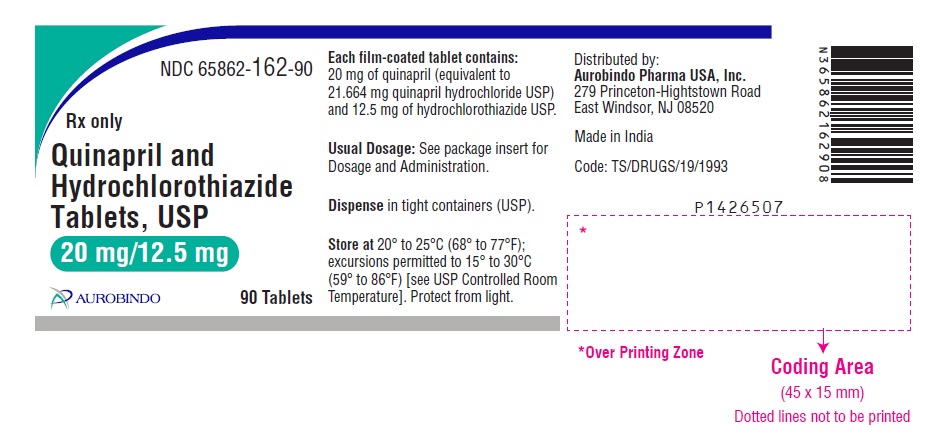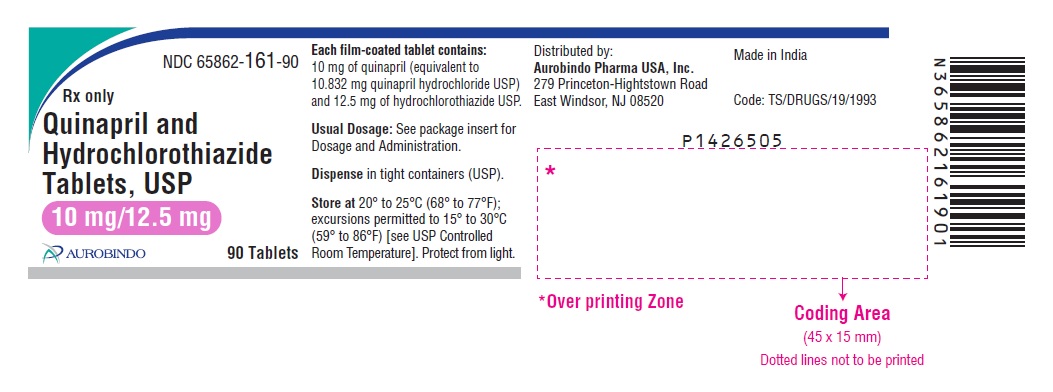Breast milk is superior in nutrition, It provides resistance against infections and allergies, It is naturally sterile. Despite all the advantages of breastfeeding some mothers choose to pause the breastfeeding in fear of harmful effects of medicines passing in breast milk. Are you wondering about breastfeeding and using Quinapril Hydrochloride/hydrochlorothiazide Tablet ? Know what is Quinapril Hydrochloride/hydrochlorothiazide Tablet and how it can affect your breast milk and whether Quinapril Hydrochloride/hydrochlorothiazide Tablet is safe for your kid or not.
What is Quinapril Hydrochloride/hydrochlorothiazide Tablet used for?
Hypertension Quinapril and hydrochlorothiazide tablets are indicated for the treatment of hypertension, to lower blood pressure. Lowering blood pressure reduces the risk of fatal and nonfatal cardiovascular events, primarily strokes and myocardial infarctions. These benefits have been seen in controlled trials of antihypertensive drugs from a wide variety of pharmacologic classes including the class to which this drug principally belongs. There are no controlled trials demonstrating risk reduction with quinapril and hydrochlorothiazide tablets. Control of high blood pressure should be part of comprehensive cardiovascular risk management, including, as appropriate, lipid control, diabetes management, antithrombotic therapy, smoking cessation, exercise, and limited sodium intake. Many patients will require more than one drug to achieve blood pressure goals. For specific advice on goals and management, see published guidelines, such as those of the National High Blood Pressure Education Program’s Joint National Committee on Prevention, Detection, Evaluation, and Treatment of High Blood Pressure (JNC). Numerous antihypertensive drugs, from a variety of pharmacologic classes and with different mechanisms of action, have been shown in randomized controlled trials to reduce cardiovascular morbidity and mortality, and it can be concluded that it is blood pressure reduction, and not some other pharmacologic property of the drugs, that is largely responsible for those benefits. The largest and most consistent cardiovascular outcome benefit has been a reduction in the risk of stroke, but reductions in myocardial infarction and cardiovascular mortality also have been seen regularly. Elevated systolic or diastolic pressure causes increased cardiovascular risk, and the absolute risk increase per mmHg is greater at higher blood pressures, so that even modest reductions of severe hypertension can provide substantial benefit. Relative risk reduction from blood pressure reduction is similar across populations with varying absolute risk, so the absolute benefit is greater in patients who are at higher risk independent of their hypertension (for example, patients with diabetes or hyperlipidemia), and such patients would be expected to benefit from more aggressive treatment to a lower blood pressure goal. Some antihypertensive drugs have smaller blood pressure effects (as monotherapy) in black patients, and many antihypertensive drugs have additional approved indications and effects (e.g., on angina, heart failure, or diabetic kidney disease). These considerations may guide selection of therapy. This fixed combination is not indicated for the initial therapy of hypertension (see DOSAGE AND ADMINISTRATION ). In using quinapril and hydrochlorothiazide tablets, consideration should be given to the fact that another angiotensin-converting enzyme inhibitor, captopril, has caused agranulocytosis, particularly in patients with renal impairment or collagen-vascular disease. Available data are insufficient to show that quinapril does not have a similar risk (see WARNINGS: Neutropenia/Agranulocytosis ). Angioedema in Black Patients Black patients receiving ACE inhibitor monotherapy have been reported to have a higher incidence of angioedema compared to non-blacks. It should also be noted that in controlled clinical trials, ACE inhibitors have an effect on blood pressure that is less in black patients than in non-blacks.
Is using Quinapril Hydrochloride/hydrochlorothiazide Tablet unsafe in breastfeeding? Can there be bad consequences for baby if I use it while breastfeeding?
There are 2 main ingredients of Quinapril Hydrochloride/hydrochlorothiazide Tablet, Quinapril and Hydrochlorothiazide. One by one we have analyzed both Quinapril and Hydrochlorothiazide for its impact on breastfeeding and based on our analysis we can conclude that Quinapril Hydrochloride/hydrochlorothiazide Tablet is safe to use in breastfeeding. We recommend you to check our analysis of Quinapril and Hydrochlorothiazide as below.
Statement of Manufacturer/Labeler about breastfeeding usage
Nursing Mothers Because quinapril and hydrochlorothiazide are secreted in human milk, caution should be exercised when quinapril and hydrochlorothiazide is administered to a nursing woman. Because of the potential for serious adverse reactions in nursing infants from hydrochlorothiazide and the unknown effects of quinapril in infants, a decision should be made whether to discontinue nursing or to discontinue quinapril and hydrochlorothiazide, taking into account the importance of the drug to the mother.
Quinapril Hydrochloride/hydrochlorothiazide Tablet Breastfeeding Analsys
SafeHigher risk on the neonatal period. Check-up for sedation, blood hypotension or weak suction.
SafeCAS Number: 58-93-5
Thiazide diuretic drug. Excretion into breast milk is clinically non-significant. No side-effects were observed in a one-month old breastfed baby whose mother was treated with this medication. Drug level in the plasma of this child was undetectable. Long-term treatment with diuretic drugs (particularly Thiazide type ones with long-lasting effect and loop-acting mechanism) may inhibit lactation, mostly if lactation is not well-established yet. Use as lower dose as possible, especially during the first postnatal month. American Academy of Pediatrics 2013: Maternal Medication Usually Compatible With Breastfeeding. WHO Model List of Essential Drugs 2002: Compatible with breastfeeding.
Quinapril Hydrochloride/hydrochlorothiazide Tablet Breastfeeding Analsys - 2
CAS Number: 85441-61-8
Because of the low levels of quinapril in breastmilk, amounts ingested by the infant are small and would not be expected to cause any adverse effects in breastfed infants.
CAS Number: 58-93-5
Hydrochlorothiazide doses of 50 mg daily or less are acceptable during lactation. Intense diuresis with large doses may decrease breastmilk production.

What if I already have used Quinapril Hydrochloride/hydrochlorothiazide Tablet?
Quinapril Hydrochloride/hydrochlorothiazide Tablet is safe in breastfeeding and should not create any health problem for your baby but in case you feel any health issue associated with Quinapril Hydrochloride/hydrochlorothiazide Tablet you should contact your doctor or health care provider. Be it pregnancy or lactation you shall keep your doctor informed.
My health care provider has asked me to use Quinapril Hydrochloride/hydrochlorothiazide Tablet, what to do?
Definitely, Quinapril Hydrochloride/hydrochlorothiazide Tablet is safe in lactation for baby. No wonder your doctor has recommended it.
If I am using Quinapril Hydrochloride/hydrochlorothiazide Tablet, will my baby need extra monitoring?
No extra baby monitoring required while mother is using Quinapril Hydrochloride/hydrochlorothiazide Tablet
Who can I talk to if I have questions about usage of Quinapril Hydrochloride/hydrochlorothiazide Tablet in breastfeeding?
US
National Womens Health and Breastfeeding Helpline: 800-994-9662 (TDD 888-220-5446) 9 a.m. and 6 p.m. ET, Monday through Friday
UK
National Breastfeeding Helpline: 0300-100-0212 9.30am to 9.30pm, daily
Association of Breastfeeding Mothers: 0300-330-5453
La Leche League: 0345-120-2918
The Breastfeeding Network supporter line in Bengali and Sylheti: 0300-456-2421
National Childbirth Trust (NCT): 0300-330-0700
Australia
National Breastfeeding Helpline: 1800-686-268 24 hours a day, 7 days a week
Canada
Telehealth Ontario for breastfeeding: 1-866-797-0000 24 hours a day, 7 days a week
Drug Brands with same Active ingredients



